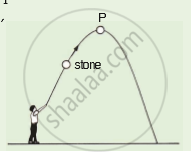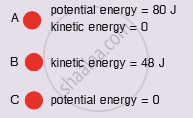Advertisements
Advertisements
Question
An automobile engine propels a 1000 kg car (A) along a levelled road at a speed of 36 km h–1. Find the power if the opposing frictional force is 100 N. Now, suppose after travelling a distance of 200 m, this car collides with another stationary car (B) of the same mass and comes to rest. Let its engine also stop at the same time. Now the car (B) starts moving on the same level road without getting its engine started. Find the speed of the car (B) just after the collision.
Solution
Here, mass of the car A, mA = 1000 kg
Initial speed of the car A, uA = 36 km h_1
= `36 xx 5/18`
= 10m s−1
Opposing frictional force, F = 100 N
∴ Power of the engine of car A
= F µA = (100 N) × (10 m s−1) = 1000 W
When car A collides with car B of mass 1000 kg,
Final speed of car A, vA = 0
Initial speed of car B, uB = 0
Applying conservation of momentum, P, = P,
mAvA + mBuB = mAvA + mBvB
1000 × 10 + 1000 x 0 = 1000 × o + 1000 × vB
∴ vB = 10m s−1
So, the speed of the car B just after the collision is 10m s−1
APPEARS IN
RELATED QUESTIONS
A body falls freely under gravity from rest. Name the kind of energy it will possess while falling.
State whether the object possess kinetic energy, potential energy, or both :
A man climbing a hill _____________.
State whether the object possess kinetic energy, potential energy, or both :
A bird running on the ground ____________.
What are the various forms of energy?
A stone is thrown upwards as shown in the diagram. When it reaches P, which of the following has the greatest value of the stone?
What kind of energy transformations take place at a coal-based thermal power station?
How much electrical energy in joules does a 100 watt lamp consume : in 1 minute?
What do you understand by the term 'transformation of energy"? Explain with an example.
A ball falls to the ground as shown below :
What is the kinetic energy of ball when it hits the ground?
The device which converts mechanical energy into energy which runs our microwave oven is :
